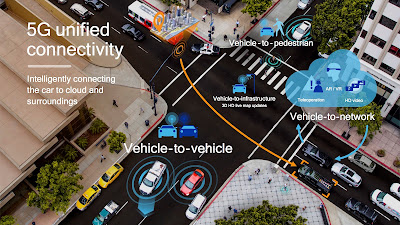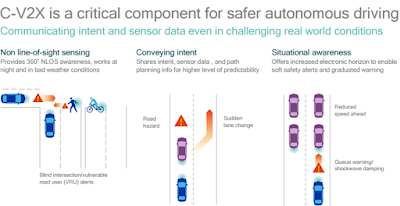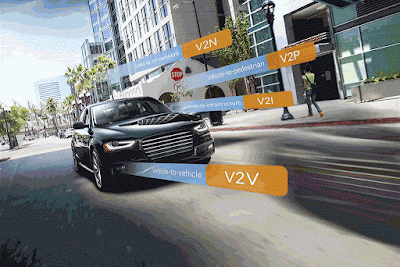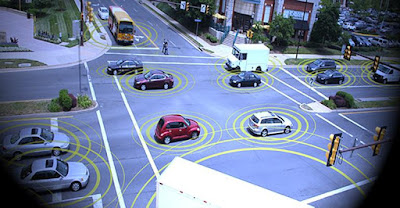V2X stands for Vehicle-to-Everything. This a mode of
communication in an “ecosystem” created by a vehicle and any other “connected” entity.
In simple words to say, communication between an electronic gadget and your
vehicle to ease the way of living.
C-V2X stands for Cellular Vehicle-to-Everything. In V2X
communication, the devices may be connected to the vehicle through ethernet,
Wi-Fi or any other communication technology. But in C-V2X, the ecosystem is
completely based upon the connectivity of the entities within a cellular network.
On 31st October, the tech giants AT&T,
Qualcomm, Ford and Nokia collaborated to announce their full-fledged R&D
for C-V2X communication technology in San Diego. In this context, this article
presents you the top ten things you should know about C-V2X for a “connected”
future.
1. C-V2X is expected to be available commercially by 2020. In
March 2017, Third Generation Partnership Project (3GPP) has finalized the specifications
for C-V2X. On the other hand, 5th Generation Automotive Association
(5GAA) has been working on defining and testing of the technology
2. C-V2X is superior in radio performance than its
predecessors. Most of the predecessors of C-V2X, including V2X, use LTE for
communication. But C-V2X draws its advantage being implemented with the most
advanced, sophisticated and efficient 5G communication technology. Hence, the performance
of C-V2X, in comparison, varies drastically.
 |
| 5G Connectivity in C-V2X |
3. C-V2X is forward and backward compatible. As C-V2X is still
under rigorous development, forward and backward compatibility issues are also
major concerns. Also, C-V2X will be the first and full-fledged application of 5G.
When a vehicle is connected to every possible entity, the amount of data
transferred between the vehicle and the entities is evidently high. Along with
high amounts of data, the data rate should also be high enough to provide flawless
communication. High throughput, high reliability, wideband carrier support and
ultra-low latency are the major advantages of 5G.
4. C-V2X is cost-effective. The world today is mobile driven. As
C-V2X is a driven by mobile communication networks, the cost to bring this
technology into real-time is lesser than other technologies. With this
advantage, deploying, managing and maintaining C-V2X is far effective.
5. C-V2X is a safe technology. 3GPP defines rigorous minimum
performance specifications that ensure a predictable, uniform and guaranteed
in-field experience to enable applications as critical as road safety.
 |
| Safety in C-V2X |
6. C-V2X is designed to work on ITS spectrum for saving lives.
Vehicles equipped with C-V2X technology can be communicated in two modes –
Active safety mode and Infotainment mode. For active safety mode, C-V2X
implements the Intelligent Transport System (ITS) spectrum to communicate with
different entities of the ecosystem. For Infotainment mode, C-V2X implements
the cellular spectrum.
7. C-V2X is designed for low-latency direct communication. C-V2X
Direct Communications provides enhanced range and reliability without relying
on cellular network assistance or coverage. It enables exchanging real-time
safety messages for V2V, V2I, and V2P without requiring any kind of cellular
subscription.
8. C-V2X is designed for high-speed vehicle use cases. With the
implementation of C-V2X, the control over a vehicle becomes more effective and
efficient. Hence, the roads can be laid supporting up to 500 Kmph ranging
speeds.
9. C-V2X features robust synchronization even without GNSS.
Global Navigation Satellite System (GNSS) is the technology used for C-V2X
vehicles for navigation. 3GPP has designed protocols for C-V2X such that the
transit is not interrupted even in the absence of GNSS.
10. C-V2X focuses on security. The C-V2X technology is being developed
in compliance with different security standards from International Organization
for Standardization (ISO), IEEE and European Telecommunication Standards
Institute (ETSI).
In vision of these advances and advantages, the momentum
driving C-V2X is increasing as different Tier-1 automobile companies, mobile
companies and semiconductor companies are joining hands to provide a “connected”
environment for transportation.












0 comments:
Post a Comment